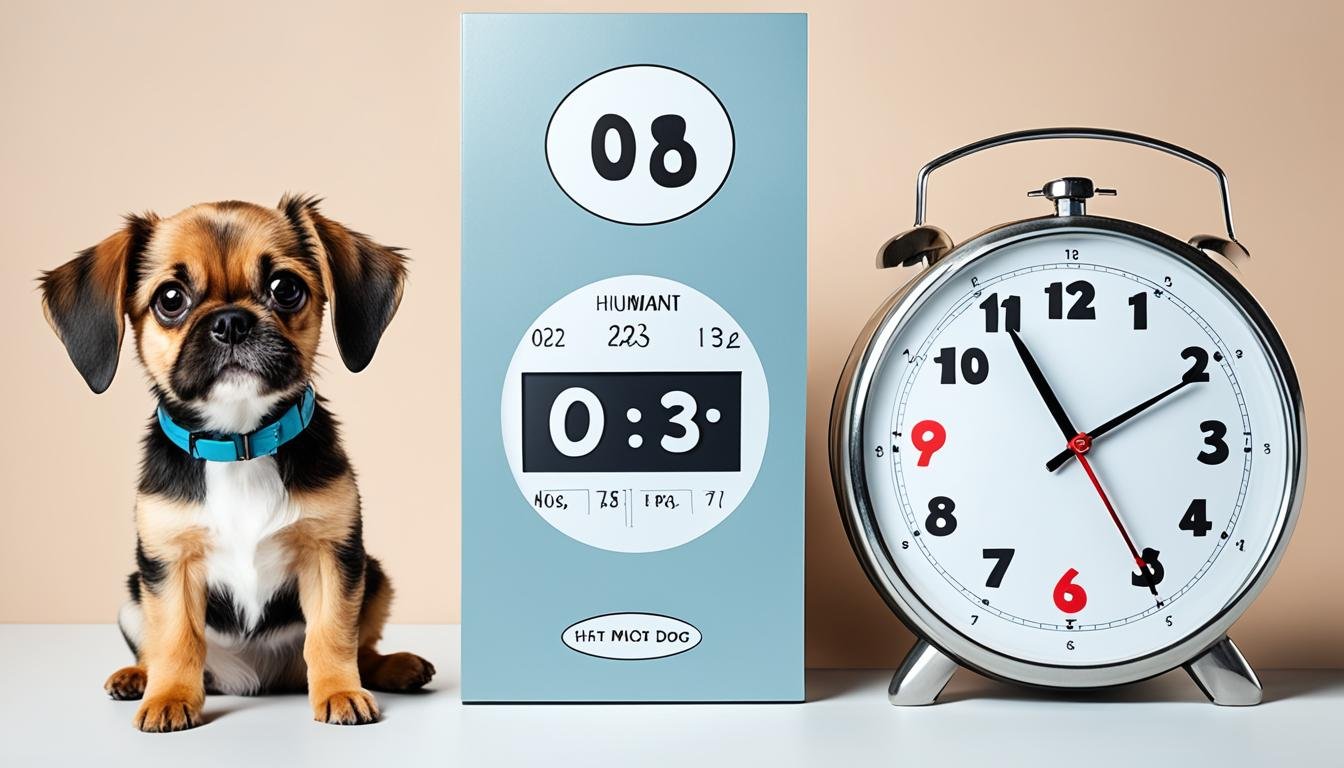Understanding the age of our furry friends is key. We have to look past the simple rule of seven. A detailed method is needed to calculate small dog years to human years correctly. This method should consider their early rapid growth and how breed size affects aging. By doing so, whether you’re using a dog age calculator or doing it by hand, you’ll better grasp their lifecycle and care needs.
If you’re aiming to convert dog years to human, new research offers enlightening information. For tiny breeds, the first two years equal 12.5 human years each. So, your pet ages a lot in just one year. By the time they’re seven, small dogs are like middle-aged humans. Knowing a dog’s age in human years is vital. It helps in giving them the best care at all stages of their life.
Debunking the Seven-Year Myth
Many believe “one dog year equals seven human years.” This theory has been around for a long time. But, canine aging is more complicated than that. New research shows that the old rule is not accurate.
Origins of the Seven-Year Rule
The seven-year idea came from comparing dog and human lifespans. People thought since dogs live about 10 years and humans 70, multiplying by seven made sense. However, this method doesn’t consider the real factors of how dogs age. It’s not a reliable way to understand their true age.
Why Veterinarians Urged Annual Pet Check-ups
Vets used the seven-year rule to stress regular pet health checks. It helped pet owners see how fast dogs age. So, it pushed for yearly check-ups to catch any health issues early.
Nowadays, we’re learning more about dog aging thanks to science. The Dog Ageing Project is studying dog genetics in detail. It’s helping us get new insights into how dogs age. This could even help human medicine in the future.
| Dog Breed | Average Lifespan (Years) | Age in Human Years (1-year-old) | Age in Human Years (5-year-old) |
|---|---|---|---|
| Dogue de Bordeaux | 5.5 | ~30 | ~57 |
| Labrador Retriever | 12 | ~31 | ~57 |
| Miniature Poodle | 14.2 | ~30 | ~57 |
Researchers in San Diego found flaws in the seven-year rule. They studied 104 Labradors and used new methods to measure aging. The old way of calculating a dog’s age doesn’t show their true life stage or growth.
Understanding dog years better leads to improved care. It matches today’s vet practices. Now, we can offer care that fits each dog’s life stage better.
Sizing Up the Situation: Size and Lifespan Correlation
In the world of dogs, size and how long they live are closely linked. Small dogs often live longer than big ones. This goes against what we see in larger animals like whales, who live a long time.
Larger Mammals vs. Small Canines
In nature, big animals usually live longer. Whales and elephants are good examples. But, this isn’t the case with dogs. Small dogs often outlive large breeds due to different health factors.
Looking at dog breeds shows us more about their aging. Small breeds like chihuahuas may live up to 18 years. Yet, larger breeds such as German shepherds live shorter, around 8 to 12 years.
The Great Dane: A Case Study in Canine Lifespan
Great Danes show how big dogs tend to have shorter lives. They live about 7 to 10 years. This could be due to more health issues and the stress of being larger.
Different dog breeds live varying lengths of time. For instance, Jack Russell Terriers can live nearly 13 years, but French Bulldogs live about 4.53 years. This shows why it’s important to look at each breed’s lifespan.
| Breed | Average Lifespan | Size Category |
|---|---|---|
| Great Dane | 7-10 years | Large |
| Chihuahua | 10-18 years | Small |
| Jack Russell Terrier | 12.72 years | Small |
| French Bulldog | 4.53 years | Medium |
| Labrador Retriever | 10-14 years | Large |
Studying life expectancy by breed helps dog owners understand health trends. It helps make better choices for their pets’ well-being.
Understanding Dog Ageing Through Science
The science of how dogs age is getting a lot of attention. The Dog Aging Project is leading the way. It looks at why dogs age differently.
Scientists have discovered that puppies and human babies grow in similar ways. They studied dogs and people to learn this. This helps them understand dog years better than before.

Most of this research has been on Labradors. But now, they want to study more dog breeds. This is important to help all dogs.
The goal is to make dogs live longer and healthier lives. This could also help people stay healthier. The idea is to improve life quality, not just make it longer.
| Breed Category | Average Lifespan | Maturity Age | Geriatric Onset |
|---|---|---|---|
| Small Dogs | 10-15 years (up to 18+) | 13-15 months | ~11 years |
| Medium Dogs | 10-13 years | N/A | ~10 years |
| Large Dogs | 8-13 years | N/A | ~8 years |
| Giant Dogs | 8-13 years | ~2 years | ~7 years |
The NIH supports this important research. It’s all about improving health and preventing diseases. Different breeds, like the Australian Cattle Dog, live different lengths of time.
What we feed dogs can affect how long they live. Dogs that eat once a day may be healthier. Knowing more about aging can help dogs live better lives. This supports the goal of longer, healthier lives for them.
Small Dog Years to Human Years: A Comparison Guide
Figuring out your pet’s age isn’t as simple as the saying, “one dog year equals seven human years.” For small dog owners, there’s a different way to see how dog years relate to human years. Small dogs usually live longer than big dogs. So, we use a special chart for them, not just the seven-year rule.
When converting dog years to human years, we look at early growth and how breeds age. The first two years of a small dog’s life are very important. They might count as 12.5 human years each. This helps us understand their age in human terms.
In 2019, University of California San Diego scientists brought a new method. They used DNA methylation patterns to convert dog years to human years. They mainly studied Labrador Retrievers, a common dog in age studies.
| Dog Age | Conversion Factor | Estimated Human Age (Years) |
|---|---|---|
| 1 Year | 12.5 | 12.5 |
| 2 Years | 12.5 | 25 |
| 3 Years | 5.5 (AVMA) | 40.5 |
| 4 Years | 5.5 (AVMA) | 51 |
| 5 Years | 5.5 (AVMA) | 61.5 |
| 6 Years | 5.5 (AVMA) | 72 |
| 7 Years | 5.5 (AVMA) | 82.5 |
This table gives us a general idea. But the actual age in human years might change based on the dog’s breed and size. For example, a Chihuahua ages differently than a Beagle.
Though these guidelines help, calculating dog years to human isn’t simple. Many factors impact how we care for aging pets. Knowing their age helps us manage their health, diet, and activity level as they get older.
Our understanding of dog aging has grown a lot. From ancient comparisons to DNA studies, we know more now. With this knowledge, we can better care for our pets. We ensure their years are happy and healthy.
Senior Dogs: When Does a Small Dog Become a Senior?
It’s key to know when a small dog becomes a senior to give them the best care. They go through many changes as they age. This means their care needs can change a lot.
Small dog breeds usually enter their senior years around 10 years old. These dogs may still be lively and active in their senior years. But it’s vital to meet their changing needs.
Seniority in Dogs and the Aging Process
Small breeds like Chihuahuas and Pomeranians aren’t seen as seniors until almost 10. But, bigger dogs age faster and become seniors around 5 years old. And giant breeds, such as Great Danes, face old age challenges by about 7 years old. So, when a dog becomes a senior depends a lot on their breed and size.
Understanding a dog’s age in human years helps us know what they need for good health. Researchers from the University of California San Diego have a new way to figure out a dog’s age in human years. This method thinks about the dog’s size and breed for a more accurate age.
Quality of Life Enhancements for Aging Dogs
To help our senior dogs live better, we can provide special dog beds for support and comfort. Toys that keep them thinking are also great for their well-being as they get older. The goal is to make their later years comfortable and happy.
Here’s a quick look at when dogs of different sizes typically become seniors:
| Breed Size | Age to Senior | Age to Geriatric | Average Lifespan (Years) |
|---|---|---|---|
| Small | 10 | 11 | 10-15 |
| Medium | 8-10 | 10 | 10-13 |
| Large | 5-6 | 8 | 8-12 |
| Giant | 5 | 7 | 8-13 |
Noticing when dogs start to age and changing how we care for them can make their lives better. By using the right care and tools, we can not only make their lives longer but healthier and happier too.
New Approaches in Canine Age Calculation
Figuring out a dog’s true age has gotten better thanks to new science methods. Now, we use a dog age equivalent calculator rooted in an epigenetic clock. This is a big change from the simple old ways. It helps us understand more about how dogs age.

The 2019 Epigenetic Clock Study Explained
In 2019, the University of California San Diego School of Medicine studied how human and dog DNA ages. They looked at DNA methylation, key in showing biological aging. This led to a better method to calculate a dog’s age. They came up with the formula: human_age = 16ln(dog_age) + 31. This formula uses the natural logarithm of a dog’s age, then multiplies by 16, and adds 31.
Though this method offers detailed insights, it keeps the idea that the first dog year equals 15 human years.
Limitations of Breed-Specific Aging Data
This deep research started with the Labrador Retriever. But, using one breed’s data for all dogs can be off. This is because breeds grow and age differently. Bigger breeds, for example, tend to live shorter lives and age faster.
It’s important to know each breed ages on its own path. Things like dental health can tell us a lot about a dog’s age. Knowing this helps pet owners care for their dogs in a way that can help them live longer, happier lives. Places like Brook Farm Veterinary Center show us how crucial regular vet visits are for a dog’s long life. This care has helped dogs live longer over time.
We keep working to better understand dogs’ ages and what they need as they grow. Advances in science, along with the love between humans and dogs, are making dog age tools better. This helps increase the well-being and life span of our canine buddies.
From Historical Anecdotes to Modern Science
People have always been fascinated by figuring out how old dogs are in human years. We’ve been curious since the time of the Cosmati Pavement at Westminster Abbey, where animal lifespans were recorded in stone back in 1268. This old way of comparing ages seems simple compared to today’s genetic studies. These studies help us understand dog aging better.
Today, we use science and genetics to learn about dog aging. The Dog Aging Project is a big study that looks at dog DNA. It aims to be the biggest study of dog genetics in the world. They’re working with over 32,000 dogs to reach their goals.
“Dogs are our link to paradise. They don’t know evil or jealousy or discontent. To sit with a dog on a hillside on a glorious afternoon is to be back in Eden, where doing nothing was not boring–it was peace.” – Milan Kundera
Research involving 600,000 British dogs shows that breed and size really matter in how long dogs live. Big dogs age faster than humans, sometimes 10 times faster. But smaller dogs can live up to 20 years. This means they age much slower compared to big dogs.
Bobi, the oldest dog ever, lived to be 31 years old. His story shows why we need to think carefully when we talk about dog years. Every dog is different.
- Small or toy breeds usually live 10-15 years and are seniors by 8-11 years.
- Medium breeds have a life span of 10-13 years, turning senior at 8-10 years.
- Large breeds live about 8-12 years, becoming seniors at 8-9 years.
- Giant breeds might only live 8-10 years, with senior years starting at 6-7 years.
To help our dogs live longer, we need to take good care of them. This means regular vet visits, taking care of their teeth, getting enough exercise, eating right, keeping a healthy weight, and having pet insurance. Taking these steps can make a big difference.
| Breed Size | Average Lifspan (Years) | Senior Age Threshold |
|---|---|---|
| Small or Toy | 10-15 | 8-11 |
| Medium | 10-13 | 8-10 |
| Large | 8-12 | 8-9 |
| Giant | 8-10 | 6-7 |
The Dog Aging Project gets support from many, including national groups and kind-hearted individuals. It helps us understand how to keep dogs like the Lancashire Heeler and the Caucasian Shepherd Dog healthy. These efforts blend old stories and new science. Together, they create a wonderful story of friendship with dogs through time.
Natural Longevity: Why Small Dogs Tend to Live Longer
It’s surprising but true: small dogs live longer than big ones. This fact clashes with other animals where big usually means living longer. Yet, a little Chihuahua can outlive a big Great Dane, even when dog breeds can vary vastly in size.
Inconsistency in Aging Across Species
Why do little dogs live longer? It’s all about their biology. While big animals like elephants live long in the wild, big dogs age faster. This makes small dogs the exception, with them often living longer than their bigger friends.
Accelerated Aging in Larger Dogs Explained
Accelerated aging means big dogs don’t live as long. Research across 74 breeds showed big dogs age faster, leading to diseases earlier. So, a Shih Tzu can live up to 14-16 years, much longer than a Saint Bernard’s 5-8 years.
Life expectancy varies in dogs, not just by size. The oldest dog, Bobi, lived to 31, far beyond the norm for big dogs. Dogs like cattle dogs can live over 20 years, much longer than middle-sized breeds.
Mixed breeds might live longer too, especially the smaller ones. How long dogs live depends on their genes, food, and care. Next, we’ll see how dog sizes really affect how long they live. We’ll notice big differences between large and small dogs.
| Breed Size | Typical Lifespan | Contributing Factors |
|---|---|---|
| Small Breeds (e.g., Yorkies, Maltese) | 14-16 years | Genetics, slower rate of aging |
| Medium Breeds (e.g., Golden Retrievers) | 10-12 years | Moderate growth rate, balanced genetics |
| Large Breeds (e.g., Saint Bernards) | 5-10 years | Accelerated growth, higher prevalence of age-related diseases |
| Mixed Breeds (Smaller Size) | Varies, often longer than purebreds | Diverse gene pool, reduced genetic health issues |
| Record Holders (e.g., Bobi) | Up to 31 years | Exceptional genetic makeup, possibly lifestyle factors |
We should rethink aging in dogs and how size affects their life. Knowing this helps owners care for all dogs, from tiny ones to the big, gentle ones.
Caring for Your Canine Companion: Health Tips for Longer Life
Looking after your dog means paying attention to their whole lifestyle. As dogs get older, their needs change. This means pet owners need to update their care routines. It’s key to know when dogs are considered senior. This is around 10-12 years for small breeds, 8-9 for mediums, and 6-7 for large or giant breeds. Knowing this helps us watch their health more closely.
Nutrition and Diet’s Role in Canine Longevity
What your dog eats plays a big role in their health and how long they live. The AAFCO provides guidelines for balanced dog diets. This is very important for older dogs to keep their brains sharp and manage their weight. Eating well can help avoid diseases linked to being overweight.
The Importance of Regular Veterinary Check-ups
Caring for dogs of all sizes includes regular vet visits. These check-ups, which should happen once or twice a year, help catch diseases early. They also include yearly blood tests. Along with these, keeping your dog active and mentally engaged is crucial. This approach ensures they have a great quality of life as they age.
FAQ
How do you calculate a small dog’s age to human years?
To find a small dog’s human age, look at breed-specific charts. The first two years count as 12.5 human years each. After that, it depends on the dog’s breed and size.
What is the origin of the seven-year rule for dog ages?
The seven-year rule is based on human and dog life expectancies. It implied that since humans live to about 70 and dogs to 10, multiplying dog years by seven makes it easy to understand their human age equivalence.
Why did veterinarians urge annual pet check-ups?
Vets suggest yearly check-ups to keep an eye on health. These visits are key as dogs get older. They help catch and treat age-related issues early, helping dogs live longer.
Why do smaller dogs tend to live longer than larger dogs?
The full reasons are unknown, but big dogs might age quicker. They’re often sicker earlier. Their fast growth might raise their disease risk.
What is canine gerontology and how does it relate to the Dog Aging Project?
Canine gerontology studies dog aging. The Dog Aging Project uses geroscience to aim for longer, better dog lives.
At what age is a small dog considered a senior?
Small dogs are often seniors at 7 years old. But health and breed can change this. Many stay active and well beyond 7.
How does the 2019 Epigenetic Clock Study calculate dog age?
The 2019 study has a new dog age formula. It uses DNA changes. Multiply the dog’s age’s natural log by 16, then add 31 to get human years.
Are there limitations to breed-specific aging data in dogs?
Yes. Such research mainly looks at certain breeds, like Labradors. So, it might not fit all dog breeds. Aging speeds differ among them.
What historical records exist regarding the comparison of dog ages to human ages?
A record is Westminster Abbey’s Cosmati Pavement from 1268. It mentions lifespans, including dogs’. But it lacks our current scientific insight.
Why do small dogs live longer than large dogs?
It’s unclear, but large dogs might age faster. This leads to health problems sooner. Studies are looking into why dog size affects lifespan differently than in other mammals.
What role does nutrition play in the longevity of dogs?
Good food is key for dogs’ long lives. The right diet prevents obesity and related health issues, thus extending a dog’s life.
How does regular veterinary care affect a dog’s lifespan?
Consistent vet visits are crucial. They allow early problem spotting and management. Preventing diseases and keeping up with check-ups boosts dog health and lifespan.















